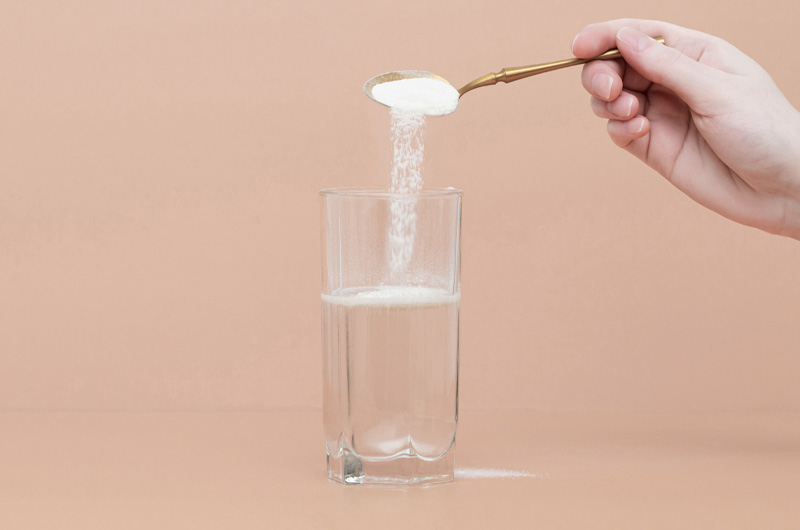Collagen, injury prevention and increased performance
author: Dr. Massimiliano Febbi PhD
Collagen is the second most abundant substance in the human body (immediately after the water), and represents about 30% of the total protein. Provides structural support for virtually all organs and soft tissues (including joints). Unfortunately, as we age, our body tends to produce less and less collagen. In fact, upon reaching 60 years of age, the ability to produce collagen is reduced by 50%, thus causing aging of the joints, loss of skin elasticity and loss of lean mass. From here it is clear that the preservation of a good mass of collagen in the joints and skin is an integral part of healthy aging.

Joints and muscles are tied together by connective tissue. In addition to providing structural integrity, connective tissue helps transmit strength, protect muscles and bones from injury, transport nutrients, and repair damaged cells. Each structure plays a different role in the muscle strength production process, which depends not only on the anatomical structure but also on the content and arrangement of the collagen Fibre.
In fact, there are different types of joint connective tissue:
- Tendons: Tendons connect muscles to bones. They are more elastic than ligaments but stiffer than muscles. They are responsible for much of the transfer of force through the body during movement.
- Ligaments: Ligaments connect bones to other bones. Their main purpose is to stabilize.
- Cartilage: Cartilage acts as a cushioning structure within the joints and between the bones. Unlike tendons and ligaments, cartilage lacks blood vessels and nerves, making it a problematic type of connective tissue for the body to repair.
- Fascia: fascia is the thin sheath of connective tissue that surrounds muscles. It plays a vital role in the transfer of force between the parts of the kinetic chain. The fascia is dense with nerve endings, making it almost as sensitive as the skin. This is part of the reason why manual therapy methods (such as foam rolling and massage) are effective for pain and tension relief. Over 80% of the muscle force produced is transferred to the surrounding connective tissue.
Intramuscular connective tissue, tendons, ligaments, and the fascia sheath that surrounds muscles are all composed primarily of collagen. In particular, from type I collagen.
In fact, there are different types of collagen (28 have been described in the literature), with specific functions and characteristics. Among the best known is type I collagen (which represents 90% of total collagen and constitutes, precisely, the main connective tissues), type II collagen (fundamental to cartilage tissue), type III (present in the dermis and blood vessels) and type IV (with support functions and component of the basement membrane).

During the recovery process from training, environmental variables such as movement habits, nutrition quality and inflammation levels can help or hinder this repair process. The two main influencing factors are the total available for cross-linking and the quality of collagen fibril formation. In terms of controllable factors, exercise has the most significant positive impact on this synthesis within the joints. Despite this, several lifestyle variables matter.
What to avoid (or better still use with caution) and what to pay attention to:
1) NSAIDs (Non-Steroidal Anti-Inflammatory Drugs), such as ibuprofen and naproxen, reduce the mass of collagen at the injury sites. A metastude published in the Annals of Physical and Rehabilitation Medicine showed that although NSAIDs are able to effectively relieve joint pain and reduce inflammation in the short term (7 to 14 days), they also delay healing times, they also increase re-injury rates of up to 25% and also reduce the mass of collagen in the injured sites. Corticosteroids also help relieve pain and inflammation in the short term, but have inhibitory effects on collagen synthesis within connective tissue.
2) A sedentary lifestyle leads to a decrease in total in the body, while exercise focused on using overloads increases the rate of collagen formation. During periods of injury recovery, a reduction in activity leads to a reduction in collagen, further increasing the risk of injury.
3) Age. this substance production decreases with age. By the age of 60, the ability to produce collagen decreased by approximately 50%.
4) An imbalance of testosterone and estrogen can inhibit this synthesis. Too much estrogen also has a detrimental effect on collagen health by decreasing its stiffness, making it easier for connective tissue to break.
Supplements to improve collagen
Before moving on to a list of supplements that have been scientifically proven to support the production of endogenous collagen, we remind you that it is possible to directly take supplements based on hydrolyzed form. Collagen is one of the most important structural Protein present in our organism, where it represents about 1/3 of the total Protein; as explained above, it is also the main constituent of connective tissue (80%), the tissue that makes up skin, muscles, hair, nails and cartilage. Of the total, 40% of collagen is contained in the skin, where it guarantees elasticity and firmness. By taking hydrolyzed one, a highly bioavailable form (that is, easily usable by our body) we will effectively supply precious bricks to restructure and recompact our skin, our joints and our tissues in general, giving greater vigor, resistance, elasticity and turgor.

Below is a list of supplements that showed to improve and support this substance production, quantity and quality.
Whey Protein: A study published in the Scandinavian Journal of Medicine and Science in Sports showed that subjects who used whey protein isolate in combination with resistance training saw a greater increase in tendon mass. A consumption of at least 20-40 grams per day recommended, ideally within an hour of exercising.
Essential Amino Acids (EAAs): While protein supplementation has more research support than using amino acid supplements, EAAs can still provide the same or better results than whey protein. Studies have shown that EAA supplementation stimulates muscle protein synthesis (MPS) more than the ever popular branched chain amino acid (BCAA) supplement, and both MPS and whey protein do. Unlike the latter, EAAs have the added benefit of creating lower insulin spikes and easier digestion.
Vitamin C + Collagen Protein: An eight-person placebo-controlled study published in the American Journal of Clinical Nutrition showed that taking vitamin C along with collagen protein can double the markers of substance synthesis in the joints of the ankle. Collagen protein and vitamin C supplements taken individually also have regenerative benefits. A study published in the Journal of Sports Science and Medicineshowed that 5 grams of collagen peptides significantly improved the perceived function of injured ankle joints and decreased the risk of new ankle injury after a three-month follow-up. A metastudio that has collected over 60 scientific studies also concluded that supplementation with collagen is effective, and stimulates the regeneration of connective tissue by increasing not only the synthesis of collagen but also that of minor components (glycosaminoglycans and hyaluronic acid).
Type II collagen: A study published in HealthMED showed that supplementing with 750mg of a natural collagen matrix composed of 93% type II collagen stimulates this substance synthesis within cartilage tissues. Isolated type II collagen supplements with dosages starting at 10-40 mg per day have also shown benefits for joint pain and inflammation.




Id like to thank you for the efforts you have put in penning this site. Im hoping to see the same high-grade blog posts by you in the future as well. In fact, your creative writing abilities has inspired me to get my own site now 😉
Good post. I learn something new and challenging on blogs I stumbleupon on a daily basis. Its always exciting to read content from other authors and use a little something from other web sites.
You’re so awesome! I don’t believe I have read a single thing like that before. So great to find someone with some original thoughts on this topic. Really.. thank you for starting this up. This website is something that is needed on the internet, someone with a little originality!
I am truly thankful to the owner of this web site who has shared this fantastic piece of writing at at this place.
This was beautiful Admin. Thank you for your reflections.